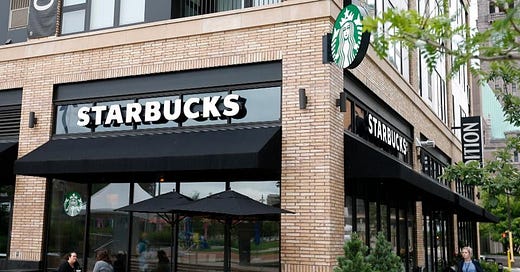Starbucks: USA's largest Radio Station📻
This week, I read up on Will Page's book Tarzan Economics which uncovered one of the most interesting data anecdotes I have come across off late.
We write a daily newsletter on all things Music, and the Business and Tech behind it. If you’d like to get it directly in your inbox, subscribe now!
What’s good everyone?
Every week, I write a segment on my learnings from the Music Industry via a book I recently picked up- Tarzan Economics by Will Page: the former Chief Economist of Spotify.
You can check out the previous editions of the segment where I talk about the scams practiced in the industry back in the 90s here.
However, today I talk about Starbucks: the world’s largest coffee chain with roughly 32,000 stores across 80 countries and a market cap of $132.5 Billion.
Headquartered in Seattle, Washington, Starbucks has a market share of 37% in the coffee industry in the USA and in effect represents the American culture of coffee around the world as well.
So why are we talking about it here?
Page writes about his time at Spotify where he had a pressing problem statement to solve around how a Meghan Trainor song: “All About that Bass” reached the top of the charts 📈 and how Starbucks ☕️ was the unusual missing piece in the puzzle in breaking it down 🧩
How exactly? Let’s get into it 👇🏻
In 2014, American Pop Star Meghan Trainor released her debut single: ‘All About That Bass’, which the headlines declared as the first song to enter the UK Charts without a physical or digital sale, and on the basis of streaming alone.
Singles charts were first started in 1952 in the UK and had been based on unit sales. However, in 2014, to accommodate for the changing behavior in music consumption, the industry hesitantly included streaming as well.
What was the logic decided? They would use a ratio of 100:1
This meant that 100 streams of a particular song would be equal to one physical/digital sale of the single.
Fair enough right?
Meghan Trainor’s song, however, got accidentally released on streaming services like Spotify a week before it was available to be downloaded on iTunes. It had unintentionally drawn a crowd large enough to take it to the Top 40.
The song was branded a ‘sleeper hit’: one that takes an unusually long time to top the charts. Determined to find out the reason for this late ascent: Page went down into the anatomy of the song. Check it out here 👇🏻
‘All About That Bass’ was performed in a throwback style of the ’50s and ’60s. The chorus was catchy and people of all ages seemed to be humming to its rhythm. So how could a ‘sleeper hit’ in the US take over a month to top the charts?
Trying to attach a logic behind the same, Page found out that the song had performed extremely well on Shazam: the song discovery platform which enables users to open its app and get to know the song playing around them in a car or at a public place.
Shazam was the bridge between lean-back discovery on radio and lean-forward discovery on your own device 📲
However, ‘All About That Bass’ had not released on any radio station, nor were there any physical CDs being sold. So how was the song being ‘Shazamed’ by people, if the only way to listen to it was via streaming apps? 🤔
This particular question ate at Page’s brain for a whole year, when a chance encounter with Emily ffrench Blake, at Spotify’s London office, seemed to solve the missing piece of the puzzle.
Emily was Global Head of Partner and New Market Sales at Spotify; someone Page describes as a street smart colleague and had recently been into meetings across America with Starbucks- in their Seattle HQ.
Page found out that data from Emily’s findings at Starbucks revealed that it was one of the biggest sources of ‘Shazams’ in the United States. The hypothesis was, owing to the sheer large number of coffee shops that Starbucks has across the States, it effectively made them one of the largest radio stations in America 📻
Seems ridiculous right? However, when you think of it, the numbers start making sense.
Any large US radio station has anywhere between 6-7 Million listeners in a month. Starbucks on the other hand alone has around 14,000 stores and around 40 million customers.
Think of all those customers queuing up to place their order, waiting to receive their coffee, and then consuming it- any customer spends roughly half an hour in the store. And music is always playing in the background right?
So if they like a particular song, why would they not Shazam it?
While this might sound convincing, it was still filled with assumptions. Page clarifies in his book 👇🏻
Basically, the fact that Starbucks was able to ‘Draw a Crowd’ meant that it had unknowingly become one of the biggest radio stations in the US.
Page further writes:
“ A music industry that had spent half a century obsessing over the impact of radio pluggers (staff responsible for getting songs played on the radio) was now contemplating replacing them with streaming playlist-pluggers.
Meghan Trainor made me realize we may need to think about Starbucks pluggers too! If labels want to have hits, they need to understand the many varied means by which hits are created”
Makes sense right? Starbucks has one of the best Music playlists going around, and they have roughly 140,000 followers on Spotify 🤯
Check out its official playlist right here 👇🏻
Hope this sorts out your music for the day 😉
Have a good one guys, and we’ll speak tomorrow! ☕️
If you liked this newsletter from Incentify, why not share it with someone you like?
P.S- Follow us on Instagram and Twitter for more such content on all things Music and Culture, now!











